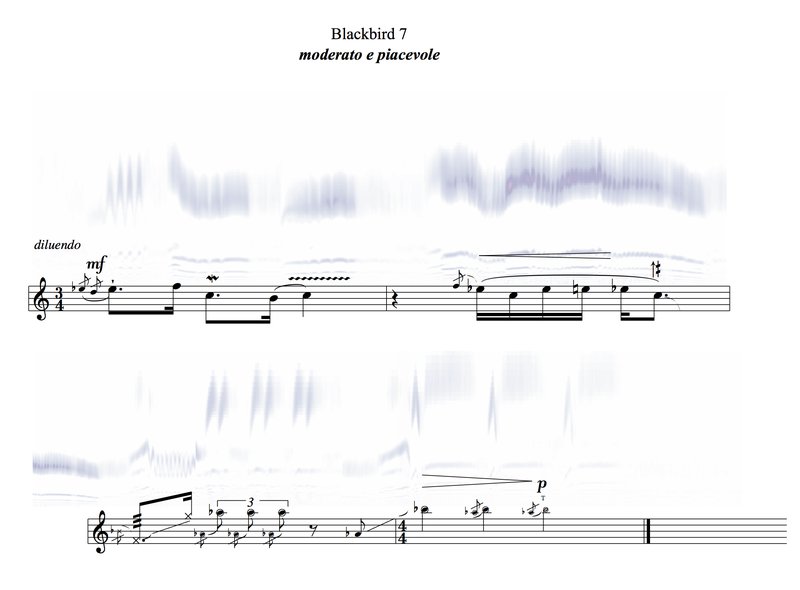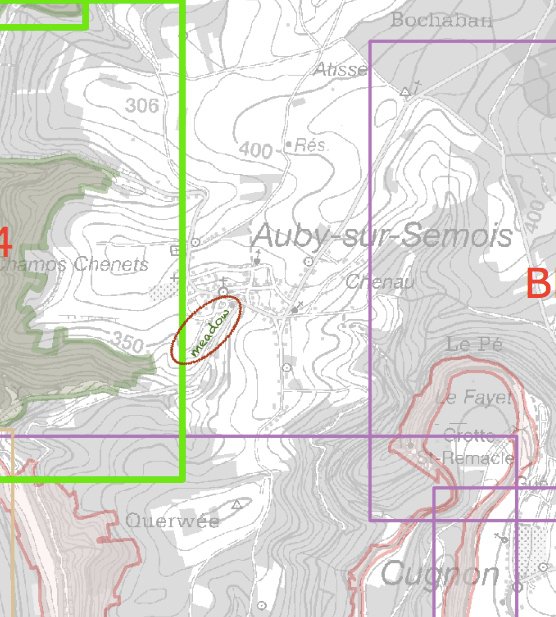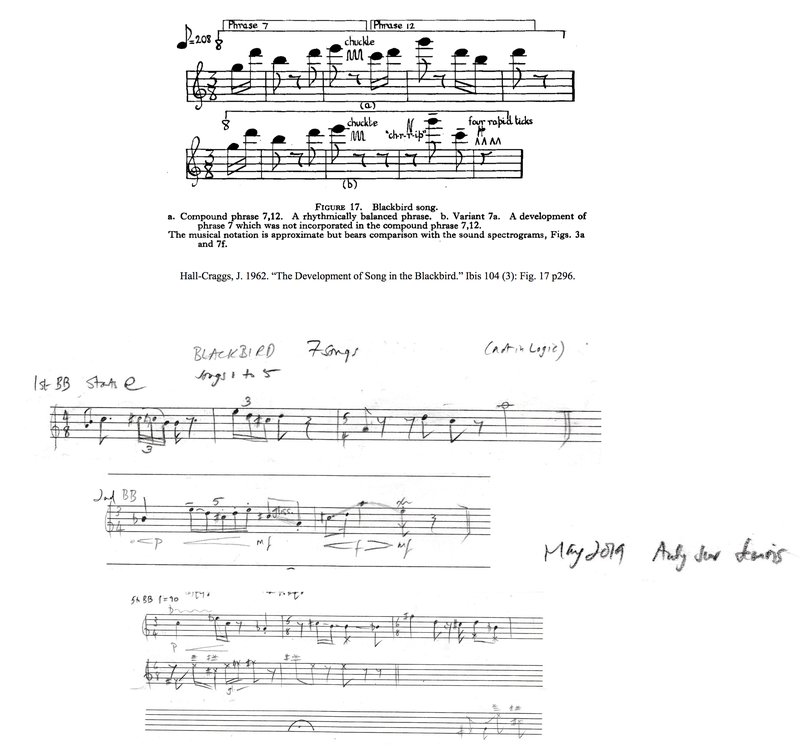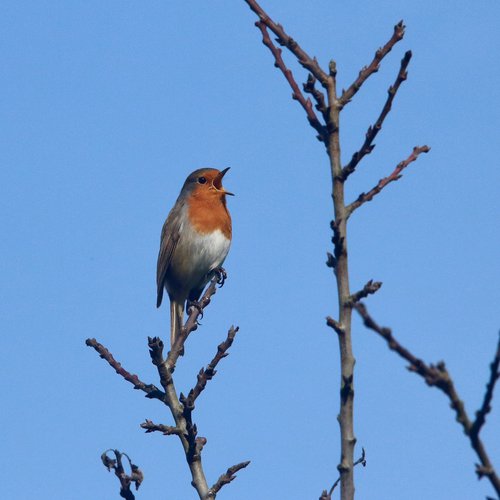Voicing the dawn
Posted Sept. 17, 2020 by Stevie WishartComposers of the air.
A memoir.

I. “Birdsong enriches humans' musical ideas and listening capabilities in their use of their soundscape by the structure of how they sing in terms of space, content and silence — for me it is a unique creative resource.”
Foam member Greta Muscat Azzopardi wrote to me recently in an exchange over George Monbiot’s Guardian article on political rewilding (roughly, a withdrawal of excessively centralised political control) : “I keep sporadically thinking about a comment you made in one of the FoAM calls about organising your place being like nature. Living Jo’s parents' big house (and dense, rambling garden) I often wonder what other thoughts and experiments you might have around this as it is a topic I am also currently wondering about.”
This in turn suggested the approach for a contribution to our current newsletter which is something of a memoir of working out how to re-wild my professional life which had become increasingly human-dominated — international travel, recording studios, air-conditioned concert-halls, and soul-less dressing-rooms, and when back in Brussels living at the former FoAM studio in the urban jungle of Molenbeek, and later in the EU Schuman quarter. Everywhere the air was not good to breathe.
The need to breathe better air meant I had to find a musical reason to change it, to shift the balance from escaping to nature* to being there, an urge all the more intense (and much influenced by FoAM) as environmental concerns were increasingly becoming a natural extension of my creativity. That’s not at all to suggest that one can contribute more to protecting the environment by being rural rather than urban — the opposite is probably more effective — but a musical excuse was called for to enable this shift from urban to rural.
Birdsong was the ideal solution, while being urban, it is even more prolific in rural environments, not necessarily in terms of birds but because lack of humans allows them to be noticed more. It was all the more appealing in being culturally and historically neutral, almost impossible to write down, and very affordable. During this time I also formed a loose Birdmusic trio with Professor Amanda Bayley, and Dr Ian Winter, visited the home and studio of the renowned ornithologist and writer, Simon Barnes, and was also influenced by conversations with Almo Farina who showed me that aspects of my music interpreted Unwelt . Coincidentally, I also had some teaching offered to me in rural locations and cloisters, and started working with Alice Oswald, an outstanding nature poet, and remember being pleasantly shocked and then relieved at how intensely she organised her work-place ‘like nature’.
II. Be like a bird

Since the decision to start working with birdsong arose not from any special knowledge of birds but from a desire to rewild my music and breathe decent air, initial bird-music forays were a steep learning curve but achieved the desired effect of minimal urban presence. The result was a Voicing the Dawn, commissioned by Ex Cathedra, a world-class vocal ensemble directed by Jeffrey Skidmore OBE and premiered in Hereford Cathedral in the early summer of 2019. It works well in complex spaces and will also be performed at the Concertgebouw in Brugges in 2021. This winter, with the mandatory self-isolation impending, I decided again to exit Brussels and re-locate to a friend’s house in Auby, a “site protégé” known as the Valley of the Aleines (le Vallon du Ruisseau des Aleines BE34044 intersection of 44-2/3/4) and like so many of us, was stuck in one place for weeks on end, and most importantly in a place of intense nature (by Belgian standards at least). With no need to travel, I thought about how to experiment with making nature my place, and the best place to start was at the beginning.
Waking around 15 minutes before sunrise and with the frost clinging on well into May, the experiment started by following the progress of the dawn-chorus, the schedule being that of the birds — waking earlier and earlier as spring unfolded. Rising with the first tweet it is possible to engage actively with the whole performance, and to be part of birds’ intense listening to another song of the same species.
Birdsong is orchestrated naturally, following a set sequence and getting increasingly diverse the earlier the curtain rises. Blackbird (Turdus merula) often solos first, as is (human) tradition, amid a slowly encroaching amorphous chorus still far away to the distant east. I recorded each dawn chorus as best I could and without access to decent recording gear I made the decision from the outset to search for good recordings done by others. There are surprisingly few which suited my need for capturing high-quality birdsong without background sounds, or perhaps it’s that they are not recorded with musicians’ ears, but anyway, my humble recordings were enough for documentation in terms of making an itinerary of the dawns in sound which was the object of the first part of this experiment.
As the experiment progressed, I dared to join in sometimes — and very little — on my baroque violin (useful because of its scratchy sound, having strings that are twisted animal sinews — sheep’s gut). I wanted to trace around the sound with the violin or my voice attempting to highlight each new sound as it entered and compose tiny soundmaps to try and work out what was going on, and have this human music embedded into the birds’ by recording both. Most of this was done using the microphone placed outside on the flat roof looking-over the meadow, me inside when playing, and sometimes I also recorded on an iphone to get the same recording from another spot. It was astonishing how just around the corner the balance of the bird orchestra was completely different* and I want to see what happens musically when I mix the same recording from various locations so that my ears can fly around a bit. At this input stage of the experiment I was making strategies for myself to learn with, while also anticipating how they would be used in music composition at the output concert and workshop stages.
Most of the birds at Auby perch at the same spot with the odd newcomer turning up each day. The church bell (cast by Causard-Slégers in 1875) starts at 5.45 a.m. — a single stroke and then at 6 a.m. its long Angelus ring making a sonic grid over which to hear the birdsong. The musical discontinuity of the birds contrasts against the tolling pulse which then fades making the birdsong phrases, or songbursts, more understandable than before.
As the dawns developed, so the birdsong became increasingly dense to my humble human ears — reminding me of how impenetrable an orchestra sounded when as a child I was planted as a violin scraper at the back the second violins. Then one dawn I noticed there was a gentle transition returning to the sparseness of the early spring, and hence more clarity. The orchestration follows that same sequence, the difference being in diversity. The key soloist is still Blackbird - and others, as well as I, have happily remarked upon how virtuosic and joyful the song has been this year. Here he is again, as one of the last remainers, as I write on this dim summer dawn, now returned to Brussels.

III. A bird song can even, for a moment, make the whole world into a sky within us … Rainer Maria Rilke
Using the simple recordings I had made, the next stage of the experiment is to see how this can be used as source material in my professional life. Unfortunately I was, as so often, too slow to meet a BBC invitation to broadcast something of my ‘dawn-violin with blackbird’ for one of their ‘home-sessions’, but realised that it would be ideal content for another commission thankfully shelved to next year, from Ensemble Variances (based at Rouen in Normandy). This ensemble is rare in having extreme expertise in performing contemporary classical music while being founded (some ten years ago) on a commitment to underwriting their music with an environmental awareness.
There’s also an educational aspect as part of the commission with masterclasses at the Conservatoire à Rayonnement Régional de Caen where the work will be premiered by the Ensemble Variances on 26 January 2021, and as part of part Bristol New Music the following April. My plan is to find aspects of birdmusic relevant and enjoyable for participants at any level of musical interest, as well as within the contemporary music niche — a challenge worth facing.

IV. Gardez la Distance, for flute, clarinet and piano
Below is my proposed development of birdsong from soft rambling sounds to full maturity, and I would welcome any comments or contributions towards this projected flight-path.
Birdsong is an age-old resource for composers, and remains an important novelty, whereas in some traditional music it was more often (and still is) one and the same ecotone. These composers of the air are colleagues to us human composers, as our ears are attuned to glimpse into their listening (soundtope) and embody, however simplistically, hints about organising our little world 'like nature’, but on a human scale. This feels magical because our ears delve into a soundworld which is tough and tantalising to fathom, yet is undoubtedly musical — if we don’t hear bird-song as music, we nonetheless hear it as song. Listening to it, makes us quiet, blend in, experience nature — composing with it as the creative core can heighten our awareness of birdsong and our need to protect it.
But, why bother? I can hear you thinking. The process and realisation of transferring the sound to the written page makes a visual metaphor (it’s an attempt to render one form in another) for understanding the complexity of birdsong, and facilitates a (human) musician in transcribing it into human form and performing this to other humans. Here we stand a fighting chance of making uplifting connections with the natural world, because we realise (an aspiration of my performance inventions and experiments shared here), that we are so much part of it.
Gardez la Distance draws on the process of how a blackbird learns its songs. I envision this as a means for the performers to learn the language of the composition (both human and avian) which will in turn be shared with the listener. The names of the movements, Subsong, Plastic Song and Song Crystallisation, are those given by ornithologists to the distinct phases of the bird's development in learning and memorising its song repertoire. The piece is driven by the interaction of spontaneity, notation, and silence on the basis of avian performance.
The development of the song of a mature blackbird over a single season has been described in detail by Joan Hall-Craggs (1962): she speaks in detail about how the short melodic songbursts or phrases are created and used in performance with "developed forms" arising from "simple basic phrases", the way an extended call can be developed from these elements, and ornamented. She sees this as a process similar to (a musician’s) “practising” and I will use this process in how the musicians practise my piece. Hall-Craggs’ experiments also reveal in detail how different birds of the same species interact, for example using imitation and antiphonal singing.
These are musical techniques that I will work into the composition, so that the musicians can interact like her Blackbirds: the piano imitates the flute, the clarinet responds antiphonally, only certain phrases are ornamented (and then in a particular manner), others can only be played to open or close a sequence, and so on — all drawing on how a blackbird strings his songs together. For the wider picture, these birdmusic strategies will inform my performance interventions where us humans are encouraged to experience something of a blackbird’s focus. Listening intently to another song way in the distance, touching however lightly on how they listen, what they are listening for, and how this affects what they sing.

V. Proposal for an experimental musical workshop based on the development of birdsong
“I envisage birdsong as a way to learn music and train the ear to listen more and judge less.”
“Although complex and nuanced, birdsong still remains accessible and inclusive, whereas complex contemporary music tends to be much less so.”
So here is a scenario for revisiting the dawn chorus but with my listening upgraded by having spent weeks with the dawn chorus. I notice that when I listen to those dawn songs a year later, even at bird-speed, I can hear the music that was hidden from me before. I am now hearing at a higher resolution.
My task as the composer, then, is to create the appropriate characteristics of all 6 phrases. This would be my interpretation of ‘characteristic recombination’ used by a blackbird, as observed by Hall-Craggs. Other features of blackbird song include Counter, Antiphonal and Communal singing — these are techniques that I want to use as ‘nurtured improvisation’. By listening intently to another song while singing our own or waiting to sing, we touch — however lightly — on how (black)birds listen, what they are listening for, and how this affects what they sing.
VI. The right to listen
So, to respond to my colleague’s question about what experiments might arise in “making one’s place like nature” these would be experiments attempting to link sound, habitat and physiology of the time and place of the dawn chorus, of evolutionary ornithology, of how birds learn to sing, and of the singular activities of birds do in terms of their music and movement.
A desire and need to hear birdsong might lead us to consider how to reduce the intrusion of background music in cafés and in green or other public spaces, on public transport, from wireless speakers strapped to hikers pulsing through the forest, or skimming even higher decibels over noisy construction sites. My music reaches out to raise awareness of the right to silence, so that we can listen to each other, have the space to think, hear nature, the trees … the birds
VII. Conclusion
So, to respond to Greta’s question about what experiments might arise in “making one’s place like nature”,
these would be experiments attempting to link sound, habitat and physiology of the time and place and this feels like part of Fo.am, which is my larger nest so to speak. In the work with dawn, this involved embodying it as a life-style, using it both as my musical instrument and creative content, culminating as a way of fulfilling a professional contract through making my place like nature. Looking to the next engagement with Gardez la Distance, I plan to unearth from the foregoing forms of development, interventions that will work as serious music (which is the task in hand), and also provide opportunities for group interaction (musicians, birders, environmentalists, rewilders, Fo.am, high-level communication facilitation, retreat …) based on experiments with nature — in this case embodying birdsong. This can involve occasional change of life-style based on shifting habitat to be very close to nature but what is more important is to make shift in learning practices from human to (black)bird.
All-importantly for this current phase of experiments everything is referenced through listening — listening to birdsong — which leads me end singing the second part of that Rilke quote…“because we feel that the bird does not distinguish between its heart and the world’s”

Thanks to Peter Gysen for the experiment’s location, to Paul de Lusignan & Maja Kuzmanovic for editorial assistance.
Bibliography
François-Bernard Mâche http://brahms.ircam.fr/francois-bernard-mache
Almo Farina, Patterns and dynamics of (bird) soundscapes: A biosemiotic interpretation, Semiotica 2014; 198: 241 – 255 https://www.degruyter.com/view/journals/semi/2014/198/article-p.xml
Alice Rudge, ‘The Sounds of People and Birds: Music, Memory, and Longing among the Batek of Peninsular Malaysia’. Hunter Gatherer Research, 2019, https://www.ucl.ac.uk/institute-of-advanced-studies/dr-alice-rudge and https://online.liverpooluniversitypress.co.uk/doi/pdf/10.3828/hgr.2018.2
Karin Bijsterveld , Sonic Skills, Listening for Knowledge in Science, Medicine and Engineering (1920s–Present)), 2018/ 2019
Stefan L. Bengtsson, Outlining an Education Without Nature and Object-Oriented Learning 2018
https://www.researchgate.net/publication/327261955_Outlining_an_Education_Without_Nature
Henrike Hultsch and Dietmar Todt, Learning to Sing, Chapter 3 in Nature’s Music The Science of Birdsong, ed. Peter Marler & Hans Slabbekoorn, 2004 http://125.234.102.146:8080/xmlui/bitstream/handle/DNULIB_52011/5099/nature%27s_music_the_science_of_birdsong_2004.pdf?sequence=1&isAllowed=y
for ornaments see pages 75 (and bibliographic references on 442 and 412)
Joeri Bruyninckx, Listening in the Field: Recording and the Science of Birdsong (Inside Technology), MIT 2018 https://mitpress.mit.edu/books/listening-field
Hall-Craggs, J. 1962. “The Development of Song in the Blackbird.” Ibis 104 (3): 277–300.
Hall-Craggs, J. 1979. “Sound Spectrographic Analysis: Suggestions for Facilitating Auditory Imagery.” Condor 81 (2): 185–192.
Rainer Maria Rilke, “The Inner Sky: Poems, Notes, & Dreams”, Translated from the German and French by Damion Searls 2010
Created: 15 Jul 2021 / Updated: 29 Oct 2021



